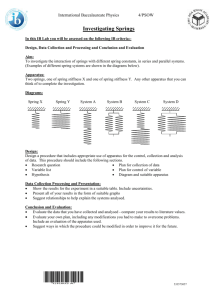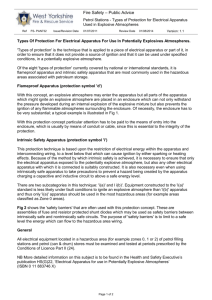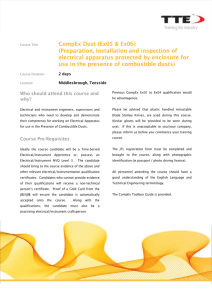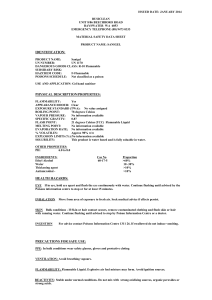Methods of explosion protection for electrical equipment METHODS
advertisement
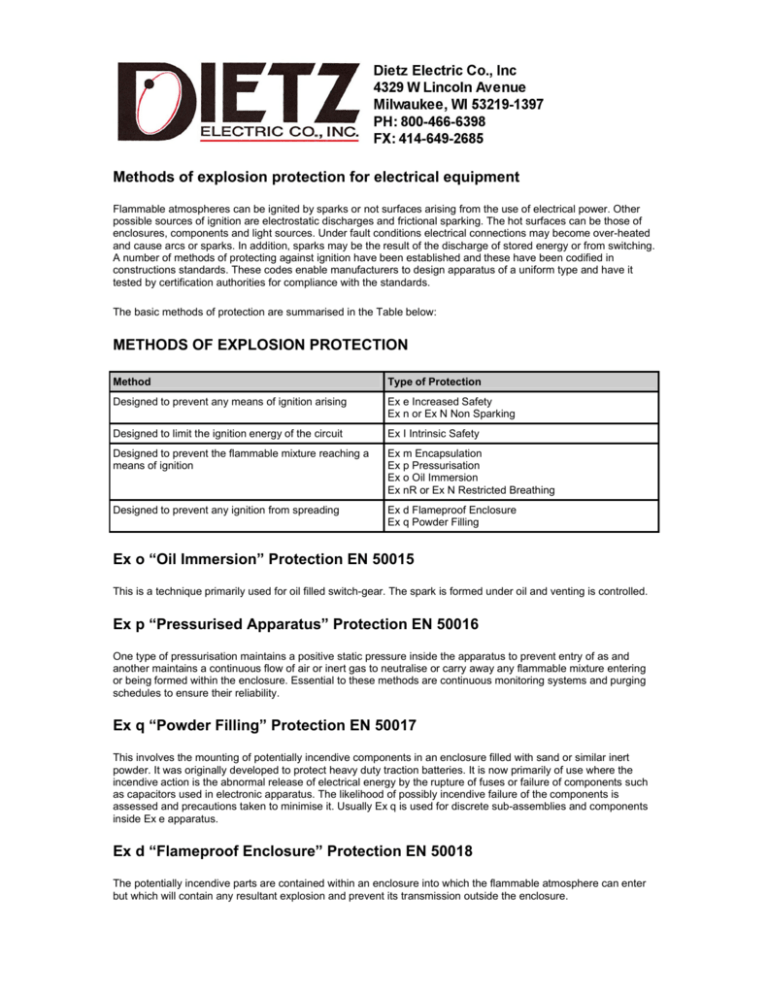
Methods of explosion protection for electrical equipment Flammable atmospheres can be ignited by sparks or not surfaces arising from the use of electrical power. Other possible sources of ignition are electrostatic discharges and frictional sparking. The hot surfaces can be those of enclosures, components and light sources. Under fault conditions electrical connections may become over-heated and cause arcs or sparks. In addition, sparks may be the result of the discharge of stored energy or from switching. A number of methods of protecting against ignition have been established and these have been codified in constructions standards. These codes enable manufacturers to design apparatus of a uniform type and have it tested by certification authorities for compliance with the standards. The basic methods of protection are summarised in the Table below: METHODS OF EXPLOSION PROTECTION Method Type of Protection Designed to prevent any means of ignition arising Ex e Increased Safety Ex n or Ex N Non Sparking Designed to limit the ignition energy of the circuit Ex I Intrinsic Safety Designed to prevent the flammable mixture reaching a means of ignition Ex m Encapsulation Ex p Pressurisation Ex o Oil Immersion Ex nR or Ex N Restricted Breathing Designed to prevent any ignition from spreading Ex d Flameproof Enclosure Ex q Powder Filling Ex o “Oil Immersion” Protection EN 50015 This is a technique primarily used for oil filled switch-gear. The spark is formed under oil and venting is controlled. Ex p “Pressurised Apparatus” Protection EN 50016 One type of pressurisation maintains a positive static pressure inside the apparatus to prevent entry of as and another maintains a continuous flow of air or inert gas to neutralise or carry away any flammable mixture entering or being formed within the enclosure. Essential to these methods are continuous monitoring systems and purging schedules to ensure their reliability. Ex q “Powder Filling” Protection EN 50017 This involves the mounting of potentially incendive components in an enclosure filled with sand or similar inert powder. It was originally developed to protect heavy duty traction batteries. It is now primarily of use where the incendive action is the abnormal release of electrical energy by the rupture of fuses or failure of components such as capacitors used in electronic apparatus. The likelihood of possibly incendive failure of the components is assessed and precautions taken to minimise it. Usually Ex q is used for discrete sub-assemblies and components inside Ex e apparatus. Ex d “Flameproof Enclosure” Protection EN 50018 The potentially incendive parts are contained within an enclosure into which the flammable atmosphere can enter but which will contain any resultant explosion and prevent its transmission outside the enclosure. Ex e “Increased Safety” Protection EN 50019 Normally sparking components are excluded. Other components are designed to substantially reduce the likelihood of the occurrence of fault conditions which could cause ignition. This is done by reducing and controlling working temperatures, ensuring the electrical connections are reliable, increasing insulation effectiveness and reducing the probability of contamination of dirt and moisture ingress. Ex i “Intrinsic Safety” Protection EN 50020 The circuit parameters are reliably controlled to reduce potential spark energy below that which will ignite the specific gas mixture. This includes the occurrence of one (coded ib) or two (coded ia) component faults and consequent failures in the circuit. It should be noted that this method does not entirely protect against the local over-heating of damaged connections or conductors. These should be kept sound and suitably enclosed against damage. Ex m “Encapsulation” Protection EN 50028 Potentially incendive components are encapsulated, usually by organic resins, which exclude the flammable atmosphere and control the surface temperature under normal and fault conditions. The likelihood of overheating and disruptive failure of the components is assessed and precautions taken to minimise the effect on the protection. Ex s “Special” Protection BASEEFA SFA 3009 This method, being by definition special, has no specific rules. In effect it is any method which can be shown to have the required degree of safety in use. Much apparatus having Ex s protection was designed with encapsulation and this has been incorporated into EN 50028. In addition, the Ex s coding is used when apparatus has been assessed to one of the individual parts of the CENELEC series but does not exactly comply with it. Ex s protection has been commonly used for Zone 0 and Zone 1 applications and its use was contained in BS 5345, the now superseded UK code of practice. Ex s is a coding referenced in IEC 60079-0. The introduction of the ATEX directive removes the need for the continuing use of the Ex s coding. Ex n “Non Sparking” Protection EN 50021 Ex N “Non Sparking” Protection BS 4533 Section 102.51 (Luminaires) & BS4683 Part 3 Precautions are taken with connections and wiring to increase reliability, though not to as high a degree as for Ex e. Where internal surfaces are hotter than the desired T rating they can be tightly enclosed to prevent the ready increases of a flammable atmosphere. This is the “restricted breathing enclosures” technique. Its employment also means that high ingress protection rating of IP65 and above are built into the design. When made to EN 50021 the coding Ex nR denotes that the protection method employs a restricted breathing enclosure. The restricted enclosure may be confined to the part of the apparatus containing the hot components such as lamps. Where the normal non-sparking construction is used the coding is nA. Other sub codes refer to simplified forms of other protection methods listed above. EN 50021 is free standing and is not a sub section of EN 50014. The Ex n/Ex N methods have been developed specifically for the design of apparatus used in the remotely hazardous area, Zone 2 and meet the requirement of ATEX category 3. Classification of hazardous areas and the use of protected apparatus The purpose of area classification is to provide a basis for the correct selection, installation and location of electrical and non-electrical equipment in those areas. Areas must be classified depending on the properties of the flammable vapours, liquids, gases, mists, combustible dusts or fibres that may be present and the likelihood that a flammable or combustible concentration or quantity is present. The aim of area classification is to avoid ignition of flammable releases that may occur in the operation of facilities. The intent is to reduce to an acceptable minimum level the probability of a flammable atmosphere and an ignition source occurring at the same time. HAZARDOUS AREAS CLASSIFICATION Zone Description Zone 0 An area in which an explosive atmosphere is continuously present or for long periods. Zone 1 An area in which an explosive atmosphere is likely to occur in normal operation(Rough guide: 10 hours or more/year but less than 1,000 hours/year) Zone 2 An area in which an explosive atmosphere is not likely to occur in normal operation and if it occurs it will exist only for a short time. (Rough Guide: less than 10 hours/year. Zone 2 is often described as the “remotely hazardous” area) The deployment of protected apparatus in hazardous areas classified to EN 60079-10 is summarised according to EN 60079-14 in the table below. SELECTION OF PROTECTED APPARATUS IN HAZARDOUS AREAS ACCORDING TO EN 60079-14 Zone Type of Protection Assigned to Apparatus Zone 0 Ex ia (refer also to EN 50284) Zone 1 Any type of protection suitable for Zone 0 and Ex d, Ex ib, Ex p, Ex e, Ex q and Ex m Zone 2 Any protection suitable for Zone 0 or 1 and Exn, Ex N and Ex o (also see notes on Ex s protection) COMBUSTIBLE DUSTS Zone Description Zone 20 An area in which combustible dust, as a cloud, is present continuously or frequently, during normal operation, in sufficient quantity to be capable of producing an explosive concentration of combustible dust in a mixture with air. Zone 21 An area, in which combustible dust, as a cloud, is occasionally present during normal operation, in a sufficient quantity to be capable of producing an explosive concentration of combustible dust in a mixture with air. Zone 22 An area, in which combustible dust, as a cloud, may occur infrequently and persist for only a short period, or in which accumulations of layers of combustible dust may give rise to an explosive concentration of combustible dust in mixture with air. Surface temperature rating and gas grouping Any flammable mixture can be classified for explosion protection under two main characteristics, temperature of ignition by a hot surface and the spark energy to ignite it. The spark energy of ignition is also related to the intensity of the explosion. This latter property is crucial to the design of the joints in flameproof enclosures (Ex d) and the energy level limit of intrinsically safe (Ex I) circuits. Other important subsidiary characteristics are the specific gravity and flash point which are used in the determination of the area classification. Surface temperature for ignition of gas The surface temperature rating is measured in the most onerous design attitude at the most severe supply voltage condition within the design tolerance. Usually this is a +10% of rates voltage for lighting and with any fault or overload condition which could normally occur in service. A normal overload condition for motors is the starting or stalled condition and for luminaries the end of life of a lamp. In the case of Ex d, Ex m, Ex q and also restricted breathing Ex nR and dust excluding enclosure methods, the maximum temperature is measured on the external surface. In other methods of protection the maximum internal temperature of the apparatus is measured. The explosive mixtures are allocated into broad bands giving the Temperature Classes shown in the table below. CLASSIFICATION OF MAXIMUM SURFACE TEMPERATURES FOR ELECTRICAL APPARATUS EN 50014 Temperature class Maximum Surface Temperature ºC T1 450 T2 300 T3 200 T4 135 T5 100 T6 85 For dust protection using the enclosure methods the surface temperature is limited to a given value in ºC, the T grouping is not used. COMPARISON OF SURFACE TEMPERATURE CLASSIFICATION IEC AND NEC Maximum Temperature ºC EN 50014 ANSI/UL844 450 T1 T1 300 T2 T2 280 280 ºC (T2) T2A 260 260º C (T2) T2B 230 230º C (T2) T2C 215 215º C (T2) T2D 200 T3 T3 180 180º C (T3) T3A 165 165º C (T3) T3B 160 160 ºC (T3) T3C 135 T4 T4 120 120º C (T4) T4A 100 T5 T5 85 T6 T6 COMPARISON OF REPRESENTATIVE GASES IN CENELEC AND NEC GAS GROUPS Explosion GroupIEC 60079-0 Explosion Group NationalElectrical Code Acetylene IIC A Carbon disulphide 11C B Representative Gas Hydrogen 11C B Ethylene oxide 11B B Hyrdrogen sulphide 11B C Ethylene 11B C Acrylo-nitrile 11A D Industrial Methane 11A D Propane 11A D Ethyl acetate 11A D GAS GROUPS FOR ELECTRICAL APPARATUS EN 50014 AND IEC 60079-0 Group Representative Gases I (all underground Coal Mining applications) Firedamp (methane) IIA Industrial methane, propane, petrol and the majority of industrial gases. IIB Ethylene, coke oven gas and other industrial gases. IIC Hydrogen, acetylene, carbon disulphide. Ingress Protection The surface temperature classification and gas grouping are the primary safety considerations. A major secondary parameter is protection against the ingress of solid bodies and liquids. In some cases the degree of ingress protection (IP) forms part of the standard requirement of the explosion protection method. Where apparatus is used in dirty or wet conditions, high resistance to ingress contributes to the reliability of explosion protection in that electrical faults within the apparatus are often the result of water ingress. DEFINITION OF INGRESS PROTECTION 1st Digit Degree of Protection(Foreign Bodies) Numeral 2nd Digit Degree of Protection(Liquids) Numeral 0 No protection 0 No protection 1 Protection against ingress of large solid foreign bodies 1 Protection against drops of water 2 Protection against ingress of medium sized solid foreign bodies 2 Protection against drops of liquid falling at any angle up to 15º from vertical 3 Protection against ingress of small solid foreign bodies greater in diameter than 2.5mm 3 Protection against rain falling at any angle up to 60º from the vertical 4 Protection against ingress of small solid foreign bodies greater in diameter than 1mm 4 Protection against splashing. Liquid splashed from any direction shall have no harmful effect. 5 Protection against the ingress of dust in an amount sufficient to interfere with satisfactory operation of the enclosed equipment 5 Protection against water projected by nozzle from any direction. 6 Complete protection against ingress of dust 6 Protection against powerful water jets. 7 Protection against temporary immersion in water. 8 Protection against indefinite immersion in water.Tests to be agreed between supplier and customer. GLOSSARY ANSI American National Standards Institute ITS Intertek Testing Services (formerly part of ERA) ATEX Abr. Directive 94/9/EC Equipment and protective systems intended for use in potentially explosive atmospheres KEMA Netherlands Testing Laboratory BASEEFA British Approvals Service for Electrical Equipment in Flammable Atmospheres NEMA National Electrical Manufacturers Association (US) BSI British Standards Institution NRTL Nationally Recognised Testing Laboratories (US) CAA Civil Aviation Authority (UK) SCS SIRA Certification Service (UK) CEN Committee European de Normalisation SOLAS Safety of Life at Sea (convention) CENELEC Committee European de Normalisation Electrique T Surface Temperature (max) CIE Commision Internationale de Leclairage Ta/Tamb Ambient Temperature CSA Canadian Standards Association UL Underwriters Laboratory Inc. EC European Communities HID High intensity discharge EECS Electrical Equipment Certification Service (UK) CFL Compact fluorescent EU The European Union MBFU Mercury vapour FM Factory Mutual (US) MBI/HQI Metal Halide IEC International Electro-technical Commission MBTF Blended mercury vapour IP Ingress Protection SON/HPS High pressure sodium ISA Instrument Society of America TH Tungsten-halogen

